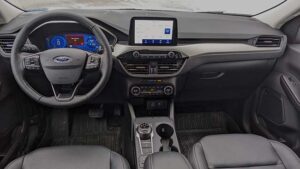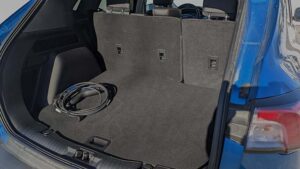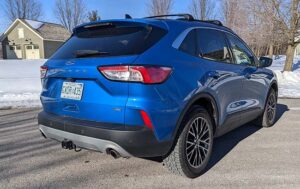2021 Ford Escape PHEV test drive
The 2021 Ford Escape comes in three powertrain choices; gasoline, hybrid or plug-in hybrid powered (PHEV). The Escape was fully redesigned in 2020 and the 2021 or 2022 models remains largely unchanged. With seating for five and a reasonable amount of storage, the Escape has been popular with value conscious buyers over the years. Truth be told, I actually bought a 2001 Ford Escape that arrived in the first shipment back when the model was introduced. I appreciated the relatively roomy interior and towing capacity provided with the 3.0L V6 engine. Back in 2000, no one was particularly concerned about fuel costs. 
The current Ford Escape maintains the strong familial resemblance that all Ford vehicles seem to share. It’s a clean design and looks far more car-like than the first generation Escape. The exterior accents and alloy 17 inch wheels were an attractive addition.
Inside the passenger cabin, the Escape’s controls were logically laid out and fell quickly to hand, except the push button to power the vehicle on and off. It’s somewhat hidden on the side of the dashboard, outside the instrument cluster concealed by the steering wheel most of the time. A minor annoyance to be sure. The Escape’s interior has a pleasant and clean design, which can feel somewhat utilitarian despite the power moonroof, optional leather seats and SYNC3 onboard technology with wireless phone charging, Apple CarPlay and Android Auto connectivity. However, the seats and driving position were comfortable over drives lasting a few hours, and likely longer.
The current Ford Escape offers a variety of four cylinder engines, 1.5L four cylinder, EcoBoost (turbocharged) engine on the S, SE and SEL trim levels. The Titanium trim models are fitted with a 2.0L four cylinder EcoBoost engine and any hybrid or plug-in hybrid models are fitted with a 2.5L normally aspirated four cylinder engine. While four-wheel-drive is offered on most models, the PHEV is only offered in front wheel drive.
Most people will be familiar with the first two types, but what exactly is a plug-in hybrid? In simplest terms, it allows drivers a choice to rely on the internal battery for all electric driving until it is exhausted. The vehicle then switches to the internal combustion engine for propulsion. The internal battery can be recharged by traditional braking, or generated by the onboard engine and also by plugging the vehicle into an external electrical source.
Several car companies have created PHEV versions of models in their line-ups. All have different strengths and weaknesses as the category is a compromise by design.
The 2021 Ford Escape Hybrid pairs the 2.5L four cylinder gasoline engine with a 96-kW electric motor, 14.4-kWh battery and a continuously variable transmission. According to Ford’s figures, the Escape PHEV will yield 61 kms of battery powered driving. That’s quite a bit more than the average Canadian will drive in a day. With longer commutes, the Escape will fully charge the battery from empty in under three hours when connected to a level 2 charger, which is the most common charger found in public spaces. Plugging in at home with the charging cable provided with the vehicle requires up to 12 hours on a 110V outlet.
In hybrid driving the vehicle was getting 6.2L per 100 kms in combined driving routes. Considering the utility of the Escape, that’s pretty incredible in these days of $1.60 litre gasoline.
The 2021 Ford Escape PHEV exhibited road manners more like a compact hatchback than the slightly more truck-like handling of the original model. I was pleasantly surprised to see the trailer hitch fitted to the PHEV and confirmed the towing capacity at 1500lbs. However, models fitted with the 2.0L Ecoboost engine, matched the 3500lb towing capacity of the original Escape. Also, fitted with winter tires and using the drive mode selection switch for snowy weather, the front wheel drive Escape had no issue navigating its way through a 20 centimetre snow fall.
 Overall, I enjoyed driving the latest model of Escape. The plugin hybrid powertrain was really the highlight of the package. Offering all electric driving for average distances, and very respectable hybrid fuel economy, it really is the biggest justification to invest in a (hard to find) 2022 Ford Escape PHEV. Supplies were quite limited, even prior to the supply chain issues currently affecting vehicle production. The vehicle used for this test was a 2021 model year unit, although the model year should be on sale already. Fortunately, other than some small trim changes, the vehicles are identical.
Overall, I enjoyed driving the latest model of Escape. The plugin hybrid powertrain was really the highlight of the package. Offering all electric driving for average distances, and very respectable hybrid fuel economy, it really is the biggest justification to invest in a (hard to find) 2022 Ford Escape PHEV. Supplies were quite limited, even prior to the supply chain issues currently affecting vehicle production. The vehicle used for this test was a 2021 model year unit, although the model year should be on sale already. Fortunately, other than some small trim changes, the vehicles are identical.
Our 2021 Ford Escape PHEV SEL trim test unit had a base price of $40,649, plus options totalling $4500, for a sticker price of $45,149 plus delivery charges.
Copyright © Auto Reviews Online 2016 | Privacy & Terms of Use | info@autoreviewsonline.com | Website by Brolly Media
